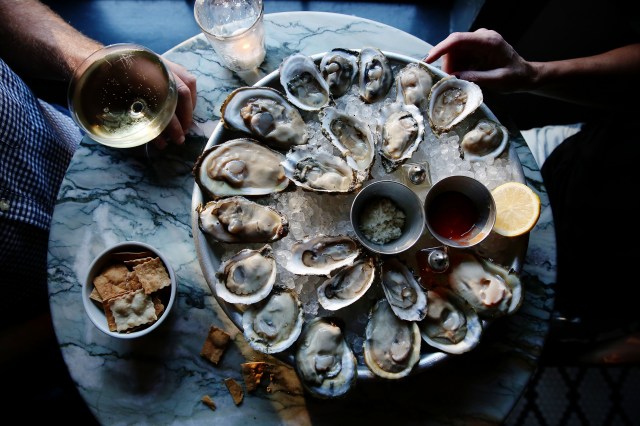The Northeast has a long history of superior oyster farming, well-known for the gems it yields.
A highlight of nearly every restaurant menu on the eastern seaboard, the rugged outer appearance and slimy inner meat of oysters may deter weary diners, but devotees of the bivalve mollusk are rewarded with a briny blend of freshness and flavor reminiscent of the sea.
A Brief Dive Into Northeast Oyster History
One of the earliest aquatic species domesticated by humans, the oyster has been a staple of indigenous diets in America long before European contact. When its industry came of age during the Civil War era, it spurred the Bloody Oyster Wars over harvest grounds in the Chesapeake Bay, which produced 14- to 20-million-bushel harvests. Since it was abundant, easy to harvest, inexpensive and nutritious, oyster demand outpaced supply in the wild and nearly collapsed the seemingly indestructible business in the 1900s.
Since the oyster life cycle takes as long as three years, oyster farming has filled in to maintain our insatiable appetite for this star of the raw bar. The floating bags used by oyster farmers for cultivation, buoys and bottom cages have sprouted along shorelines and inlets throughout the Northeast. These varied marine habitats, from Long Island Sound to Narragansett Bay and Cape Cod, determine everything about the oysters – from shape and size to flavor and brininess – and are responsible for making Northeast oysters among the best in the world.
A Superior Shellfish
Oysters command over half of total mollusk sales nationwide, according to Aquaculture North America. Sustainability and environmental benefits, along with flavor, have helped to catapult its popularity.
A crucial component to ocean health, oysters begin as free-floating larvae, attaching to rocks, docks or any submerged surface. They grow into a sustainable reef, promoting biodiversity and creating a habitat for other marine animals and plants. That reef provides a barrier during storms, preventing erosion and protecting vulnerable coastline.
One oyster filters up to 50 gallons of surrounding waters per day, which improves water quality, increases fish habitat and reduces nutrient influx from land.

Northeast Oyster Farming
Massachusetts
South Shore and Cape Cod oyster farming gives Massachusetts its street cred.
The muddy, windswept flat of Duxbury Bay, 40 miles south of Boston, is the prime spot to grow the brutally briny and fat Duxbury oyster, and Island Creek Oysters is the region’s inaugural farmer. Book a tour to see the aquaculture process directly from the source and slurp down a few oysters at their freshest.
Cotuit Oyster Company, in the Barnstable village of Cotuit on Cape Cod, is the oldest oyster farming business in the country, having raised Cotuit oysters since 1837. The clear and cold streams, estuaries and marshes here mean these oysters have a distinctly bright ocean taste. If you can’t enjoy in person, they harvest and ship fresh to your door within 24 hours, which is a service many oyster farms offer.
Rhode Island
It’s no surprise oysters were the most abundant shellfish in Rhode Island until the early 1900s. Its inlets and salt ponds are quintessential for cultivation.
Matunuck Oyster Bar in South Kingstown is a “pond to plate” operation, growing, harvesting and serving its prime Potter Pond oysters with a water view since 2002.
On the Sakonnet River in Narragansett Bay, Aquidneck Island Oyster Company launched its first-class bivalve operation in 2020. They are available at local restaurants including Midtown Oyster Bar, Coast Guard House and TwoTen Oyster Bar.
Connecticut
Designated Connecticut’s state shellfish in 1989, oysters have been a staple here since the colonial era, when fishermen harvested wild oysters almost to the brink of extinction.
In 1850, 250 schooners imported two million bushels of oysters to New Haven, and by the 1890s, the world’s largest fleet of oyster steamships operated here. The founder of Copps Island Oysters was part of that resuscitation, and remains a fourth-generation family-operated farm, with food truck and catering services. Based in Norwalk, or “Oyster Town,” they grow three varieties of deep cupped oysters on the natural sea floor, where shallow water, swift currents and sandy bottoms create a balance of brininess, sweetness and minerals.
Further up Long Island Sound in Niantic Bay, the Niantic Bay Shellfish Farm also offers plump, sweet and buttery oysters that take on the terroir of their native waters.
New York
Oysters thrived in New York’s brackish harbors, and in the early 1600s, 350 miles of reefs surrounded the island city, constituting half of the world’s oyster population. At its 19th century zenith, residents ate one million oysters every day, but their shell disposal methods contaminated area waters and overharvesting led to the closure of New Yok City oyster beds in 1927.
Now sustainable farms cultivate fresh native oysters, including Widow’s Hole Oyster Farm in Greenport, Long Island, where visitors can tour the beds and learn a two-decade long practice. Peconic Pearls, also cultivated on Long Island, are grown in a modern marine hatchery before they are planted in Peconic Bay by the Noank Aquaculture Cooperative, leading to fresh, juicy morsels.
New Jersey
The intersection of the Hudson River and Atlantic Ocean was long considered the bellwether of oyster growth, with its cold, intertidal estuary helping oysters develop stronger flavor. Indigenous populations collected oysters here in dugout canoes for more than 2000 years, when miles of New Jersey coastline were girdled by mudflat channels and sand basins covered in eelgrass. It was the epitome of tide to table, until oyster production peaked in New Jersey from 1880 to 1930.
Today, Ocean City Oyster Company by G.E.I. Oyster Farm in Great Egg Harbor Bay floats bags atop the water’s surface, so the oysters rise and fall with the tide as they grow, instilling unique local flavor. Sweet Amalia Oyster Farm in Cape May hand harvests each deep-cupped shellfish for superior freshness, imparting a delicate burst of minerality, earthiness and crispness.
Where to you go to eat oysters? Tell us in the comments.
For more local delicacies, check out the recipes and chef tips from AAA-recommended restaurants in Diamond Dish.
2 Thoughts on “Oyster Farming in the Northeast”
Leave A Comment
Comments are subject to moderation and may or may not be published at the editor’s discretion. Only comments that are relevant to the article and add value to the Your AAA community will be considered. Comments may be edited for clarity and length.















You left out Maine. The Maine Oyster Trail along the Daramiscotta River is the ultimate destination for oyster lovers. Do your research!
I started Oyster farming (with a generous grant) in Peconic Bay with a group of my Marine Biology students about 20 years ago. It was a valuable lesson in ecology, sustainability and culinary delight. I continued on and off for several years on my own until the constant travelling (about 35 miles from my home) got to be a bit inconvenient. I still go to the site to visit however. Mariculture is a fulfilling and satisfying experience and gives a great sense of marine ecology.